
|
Flying-Foxes
in Australia
|
 |
Bats are mammals
which give birth to live young and produce milk to feed them. Over sixty different
kinds occur in Australia. Most eat insects, but eight feed only on flowers and
fruit, and are known as fruit-bats or flying-foxes. Four of these are amongst
the world's largest bats (links to pictures of these are provided below). They
may weigh up to one kilogram and their wings may span more than a metre. Because
they are large and can fly long distances they can cause considerable damage
to cultivated fruit. There are several other kinds which are much smaller animals
and are rarely a problem.
Which Kind?
Identification of the larger flying-foxes is fairly simple. Photographs and points of recognition are provided in the following links and the map below describes their national distribution. More than one kind may be present in some areas.
 Click here for flying-fox sound
Click here for flying-fox sound |
The preferred food of flying-foxes is the blossom of eucalypts and some other native trees, and various bush fruits, like Moreton Bay Fig. The bats are beneficial to the trees because they act as pollinators and dispersers of their seeds. The great distances they can fly means they carry pollen and seeds far from the parent tree.
Camps are places where the large flying-foxes gather during the day, sometimes in many thousands. Along the coast they may be in mangroves, further inland they are often in deep gullies or rainforest patches, and west of the Dividing Range they are usually along water-courses. Their location may be known only to a few local people. The same campsites tend to be used year after year, although not necessarily every year, or all year round.
Damage to
cultivated fruit varies greatly from one year to the next and between different
areas. The factors controlling it are not well understood. Some areas rarely
experience attacks, others do so most years. Widespread shortages of natural
food, such as occur during droughts, may cause large numbers of animals to move
well beyond their usual range in search of food. This applies particularly to
Little Red Flying-foxes, which occur further inland than the other species.
Finding the Answers
Scientists are attempting to document the behaviour of flying-foxes so that damage to cultivated fruit can be predicted and controlled. One method of doing this is to band bats, but keeping track of large numbers of animals over the vast distances involved is well beyond the scope of a few people and, like weather recording, requires support from the public.
Public involvement is vital if we are to resolve some important questions about flying-fox biology:
 |
Metal or plastic
bands are placed on one or both of the flying-fox's "thumbs". A number and a
return address is stamped on each band. Maximum information can be gained if
scientists are able to examine the whole animal.
Photo by G.B. Baker
|
|